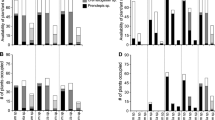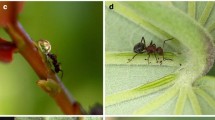Abstract
Geographic variation in the outcome of interspecific interactions may influence not only the evolutionary trajectories of species but also the structure of local communities. We investigated this community consequence of geographic variation for a facultative mutualism between ants and wild cotton (Gossypium thurberi). Ants consume wild cotton extrafloral nectar and can protect plants from herbivores. We chose three sites that differed in interaction outcome, including a mutualism (ants provided the greatest benefits to plant fitness and responded to manipulations of extrafloral nectar), a potential commensalism (ants increased plant fitness but were unresponsive to extrafloral nectar), and a neutral interaction (ants neither affected plant fitness nor responded to extrafloral nectar). At all sites, we manipulated ants and extrafloral nectar in a factorial design and monitored the abundance, diversity, and composition of other arthropods occurring on wild cotton plants. We predicted that the effects of ants and extrafloral nectar on arthropods would be largest in the location with the mutualism and weakest where the interaction was neutral. A non-metric multidimensional scaling analysis revealed that the presence of ants altered arthropod composition, but only at the two sites in which ants increased plant fitness. At the site with the mutualism, ants also suppressed detritivore/scavenger abundance and increased aphids. The presence of extrafloral nectar increased arthropod abundance where mutual benefits were the strongest, whereas both arthropod abundance and morphospecies richness declined with extrafloral nectar availability at the site with the weakest ant–plant interaction. Some responses were geographically invariable: total arthropod richness and evenness declined by approximately 20% on plants with ants, and extrafloral nectar reduced carnivore abundance when ants were excluded from plants. These results demonstrate that a facultative ant–plant mutualism can alter the composition of arthropod assemblages on plants and that these community-level consequences vary across the landscape.



Similar content being viewed by others
References
Barton AM (1986) Spatial variation in the effect of ants on an extrafloral nectary plant. Ecology 67:495–504
Bastolla U, Fortuna MA, Pascual-García A, Ferrera A, Luque B, Bascompte J (2009) The architecture of mutualistic networks minimizes competition and increases biodiversity. Nature 458:1018–1020
Begon M, Townsend CR, Harper JL (2006) Ecology: individuals, populations, and communities, 4th edn. Blackwell, Malden
Berenbaum MR, Zangerl AR (2006) Parsnip webworms and host plants at home and abroad: trophic complexity in a geographic mosaic. Ecology 12:3070–3081
Blüthgen N, Stork NE (2007) Ant mosaics in a tropical rainforest in Australia and elsewhere: a critical review. Austral Ecol 32:93–104
Brodie ED, Ridenhour BJ (2002) The evolutionary response of predators to dangerous prey: hotspots and coldspots in the geographic mosaic of coevolution between garter snakes and newts. Evolution 56:2067–2082
Bronstein JL (1994) Our current understanding of mutualism. Q Rev Biol 69:31–51
Bronstein JL (1998) The contribution of ant-plant protection studies to our understanding of mutualism. Biotropica 30:150–161
Bronstein JL, Wilson WG, Morris WE (2003) Ecological dynamics of mutualist/antagonist communities. Am Nat 162:S24–S39
Bronstein JL, Alarcon R, Geber M (2006) The evolution of plant-insect mutualisms. New Phytol 172:412–428
Bruno JF, Stachowicz JJ, Bertness MD (2003) Inclusion of facilitation into ecological theory. Trends Ecol Evol 18:119–125
Cheney KL, Cote IM (2005) Mutualism or parasitism? The variable outcome of cleaning symbioses. Biol Lett 1:162–165
Clarke KR, Gorley RN (2007) Primer, version 6.1.10: user manual and tutorial. Primer-E, Plymouth
Clarke KR, Somerfield PJ, Airoldi LWRM (2006) Exploring interactions by second-stage community analyses. J Exp Mar Biol Ecol 338:179–192
Cuautle M, Rico-Gray V (2003) The effect of wasps and ants on the reproductive success of the extrafloral nectaried plant Turnera ulmifolia. Funct Ecol 17:417–423
de la Fuente MAS, Marquis RJ (1999) The role of ant-tended extrafloral nectaries in the protection and benefit of a Neotropical rainforest tree. Oecologia (Berlin) 118:192–202
Despres L, Ibanez S, Hemborg AM, Godelle B (2007) Geographic and within-population variation in the globeflower-globeflower fly interaction: the costs and benefits of rearing pollinators’ larvae. Oecologia 151:240–250
Di Giusto B, Anstett M, Dounias E, McKey DB (2001) Variation in the effectiveness of biotic defense: the case of an opportunistic ant-plant protection mutualism. Oecologia 129:367–375
Edelaar P, Benkman CW (2006) Replicated population divergence caused by localized coevolution? A test of three hypotheses in the red crossbill-lodgepole pine system. J Evol Biol 19:1651–1659
Elias M, Gompert Z, Jiggins C, Willmott K (2008) Mutualistic interactions drive ecological niche convergence in a diverse butterfly community. PLoS Biology 6:2642–2649
Fernandes GW, Fagundes M, Woodman RL, Price PW (1999) Ant effects on three-trophic level interactions: plant, galls, and parasitoids. Ecol Entomol 24:411–415
Fryxell PA (1979) The natural history of the cotton tribe. Texas A&M University Press, College Station
Gaume L, McKey D, Terrin S (1998) Ant-plant-homopteran mutualism: how the third partner affects the interaction between a plant-specialist ant and its myrmecophyte host. Proc R Soc Lond B 265:569–575
Gotelli NJ, Colwell RK (2001) Quantifying biodiversity: procedures and pitfalls in the measurement and comparison of species richness. Ecol Lett 4:379–391
Gove AD, Rico-Gray V (2006) What determines conditionality in ant-Hemiptera interactions? Hemiptera habitat preference and the role of local ant activity. Ecol Entomol 31:568–574
Hanson HC (1923) Distribution of Arizona wild cotton. Arizona Exp Stn Tech Bull 3:48–59
Hay ME et al (2004) Mutualisms and aquatic community structure: the enemy of my enemy is my friend. Annu Rev Ecol Evol Syst 35:175–197
Horvitz CC, Schemske DW (1984) Effects of ants and an ant-tended herbivore on seed production of a neotropical herb. Ecology 65:1369–1378
Kaplan I, Eubanks MD (2005) Aphids alter the community-wide impact of fire ants. Ecology 86:1640–1649
Kersch MF, Fonseca CR (2005) Abiotic factors and the conditional outcome of an ant-plant mutualism. Ecology 86:2117–2126
Lach L (2008) Argentine ants displace floral arthropods in a biodiversity hotspot. Divers Distrib 14:281–290
Lukefahr MJ (1960) Effects of nectariless cottons on populations of three lepidopterous insects. J Econ Entomol 53:242–244
Mathews CR, Bottrell DG, Brown MW (2009) Extrafloral nectaries alter arthropod community structure and mediate peach (Prunus persica) plant defense. Ecol Appl 19:722–730
McCune B, Grace JB (2002) Analysis of ecological communities. MjM Software Design, Gleneden Beach
Mody K, Linsenmair KE (2004) Plant-attracted ants affect arthropod community structure but not necessarily herbivory. Ecol Entomol 29:217–225
Mooney KA (2007) Tritrophic effects of birds and ants on a canopy food web, tree growth, and phytochemistry. Ecology 88:2005–2014
Ness JH (2006) A mutualism’s indirect costs: the most aggressive plant bodyguards also deter pollinators. Oikos 113:506–514
Peterson MA (1995) Unpredictability in the facultative association between larvae of Euphilotes enoptes (Lepidoptera: Lycaenidae) and ants. Biol J Linn Soc 55:209–233
Renault CK, Buffa LM, Delfino MA (2005) An aphid-ant interaction: effects on different trophic levels. Ecol Res 20:71–74
Rey PJ, Manzaneda AJ (2007) Geographical variation in the determinants of seed dispersal success of a myrmecochorous herb. J Ecol 95:1381–1393
Rico-Gray V, Palacios-Rios M, Garcia-Franco JG, Mackay WP (1998) Richness and seasonal variation of ant-plant associations mediated by plant-derived food resources in the semiarid Zapotitlan Valley, Mexico. Am Midl Nat 140:21–26
Rose USR, Lewis J, Tumlinson JH (2006) Extrafloral nectar from cotton (Gossypium hirsutum) as a food source for parasitic wasps. Funct Ecol 20:67–74
Rudgers JA (2004) Enemies of herbivores can shape plant traits: selection in a facultative ant-plant mutualism. Ecology 85:192–205
Rudgers JA, Clay K (2008) An invasive plant-fungal mutualism reduces arthropod diversity. Ecol Lett 11:831–840
Rudgers JA, Gardener MC (2004) Extrafloral nectar as a resource mediating multispecies interactions. Ecology 85:1495–1502
Rudgers JA, Strauss SY (2004) A selection mosaic in the facultative mutualism between ants and wild cotton. Proc R Soc Lond B Biol Sci 271:2481–2488
Rudgers JA, Hodgen JG, White JW (2003) Behavioral mechanisms underlie an ant-plant mutualism. Oecologia 135:51–59
Rudgers JA, Holah J, Orr SP, Clay K (2007) Forest succession suppressed by an introduced plant-fungal symbiosis. Ecology 88:18–25
SAS Institute (2004) SAS version 9.1.3. SAS Institute, Cary
Savage AM, Peterson MA (2007) Mutualism in a community context: the positive feedback between an ant-aphid mutualism and a gall-making midge. Oecologia 151:280–291
Schuster MF, Lukefahr MJ, Maxwell FG (1976) Impact of nectariless cotton on plant bugs and natural enemies. J Econ Entomol 69:400–402
Smith RL, Flint HM (1977) A bibliography of the cotton leafperforator, Bucculatrix thurberiella, and a related species, Bucculatrix gossypiella, that also feeds on cotton (Lepidopteran: Lyonetiidae). Bull Entomol Soc Am 23:195–198
Stachowicz JJ (2001) Mutualism, facilitation, and the structure of ecological communities. Bioscience 51:235–246
Stapel JO (1997) Extrafloral nectar, honeydew, and sucrose effects on searching behavior and efficiency of Microplitis croceipes (Hymenoptera: Braconidae) in cotton. Ann Entomol Soc Am 26:617–623
Styrsky JD, Eubanks MD (2007) Ecological consequences of interactions between ants and honeydew-producing insects. Proc R Soc Lond B 274:151–164
Taylor RM, Pfannenstiel RS (2008) Nectar feeding by wandering spiders on cotton plants. Environ Entomol 37:996–1002
Thompson JN (2005) The geographic mosaic of coevolution. University of Chicago Press, Chicago
Thompson JN, Cunningham BM (2002) Geographic structure and dynamics of coevolutionary selection. Nature 417:735–738
Thompson JN, Fernandez CC (2006) Temporal dynamics of antagonism and mutualism in a geographically variable plant-insect interaction. Ecology 87:103–112
Thrall PH, Slattery JF, Broadhurst LM, Bickford S (2007) Geographic patterns of symbiont abundance and adaptation in native Australian Acacia-rhizobia interactions. J Ecol 95:1110–1122
van der Heijden MGA, Wiemken A, Sanders IR, Erhardt A (1998) Mycorrhizal fungal diversity determines plant biodiversity, ecosystem variability and productivity. Nature 396:69–72
von Ende CN (2001) Repeated measures analysis: growth and other time dependent measures. In: Scheiner SM, Gurevitch J (eds) Design and analysis of ecological experiments. Oxford University Press, New York, pp 134–157
Wimp GM, Whitham TG (2001) Biodiversity consequences of predation and host plant hybridization on an aphid-ant mutualism. Ecology 82:440–452
Acknowledgments
We are indebted to R. Karban, who introduced us to the wild cotton system. Thanks are also extended to P. Ward (UC-Davis) and C. Olson, Associate Curator of the University of Arizona Insect Collection, for assistance with species identifications. J. Hodgen, W. White, C. Stephens, D. Hoyer, A. Stein, J. Howard, J. M. Rudgers, B. Bedard, and P. Murch provided invaluable field assistance. K. Whitney offered advice and help of many kinds. Thanks to S. Chamberlain, A. Dunham, J. Ness, M. Peterson, G. Wimp, and anonymous reviewers for improvements to this manuscript. This work was supported by an EPA S.T.A.R. fellowship and the Godwin Assistant Professorship to J.A.R. and a Wray-Todd fellowship to A.M.S. The research practices used for this study complied with all laws and regulations of the USA.
Author information
Authors and Affiliations
Corresponding author
Additional information
Communicated by Volkmar Wolters.
Electronic supplementary material
Below is the link to the electronic supplementary material.
Rights and permissions
About this article
Cite this article
Rudgers, J.A., Savage, A.M. & Rúa, M.A. Geographic variation in a facultative mutualism: consequences for local arthropod composition and diversity. Oecologia 163, 985–996 (2010). https://doi.org/10.1007/s00442-010-1584-6
Received:
Accepted:
Published:
Issue Date:
DOI: https://doi.org/10.1007/s00442-010-1584-6




